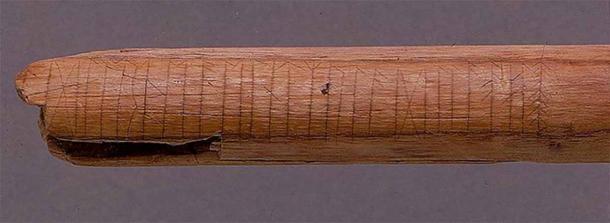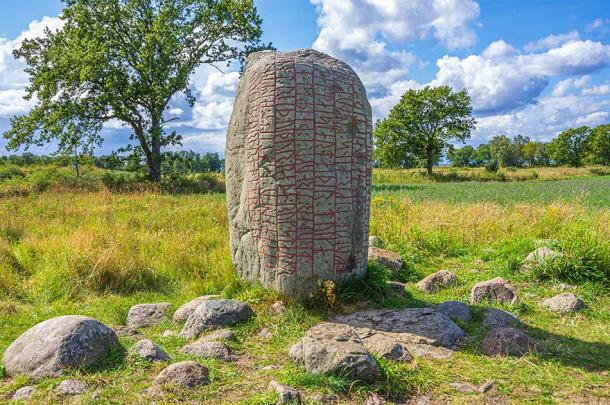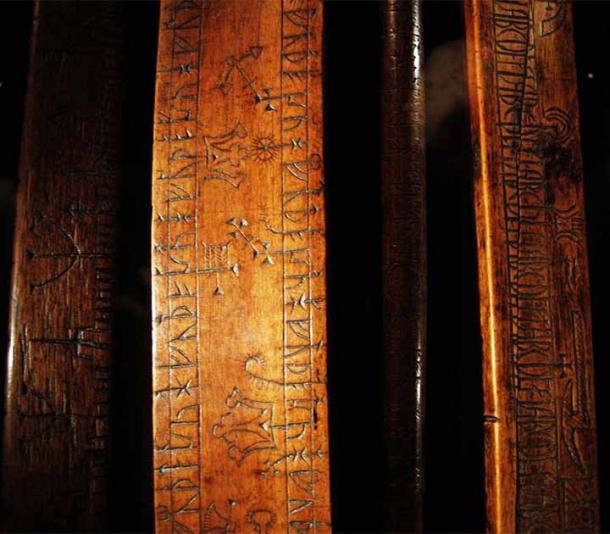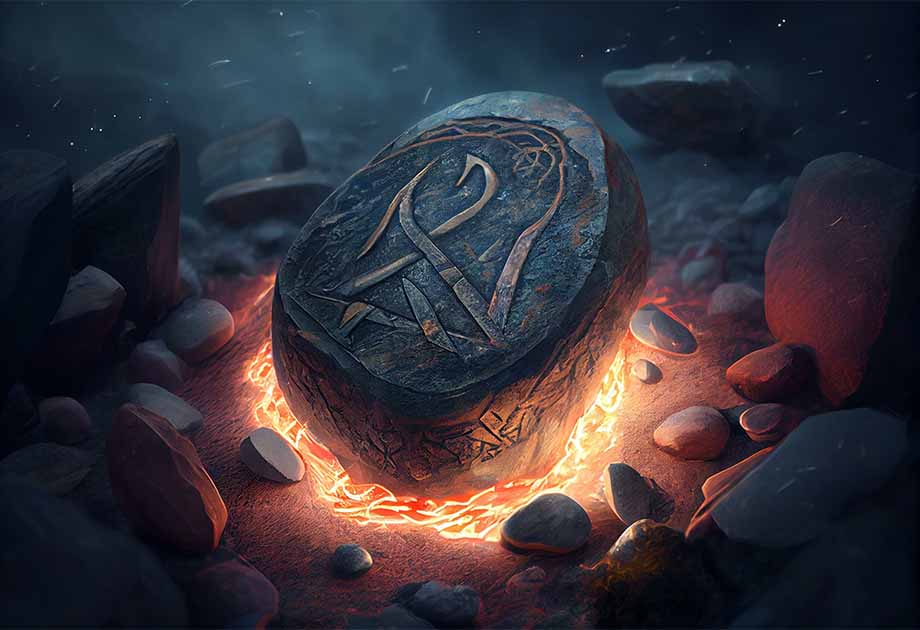Unlocking the Cryptic Viking Code Using Runic Writing and Ancient DNA
Runic script is an alphabetic system based on a non-alphabetical order row. This means that it has letters, like in many languages, but the letters are not arranged in a standard alphabetical order. Instead, the letters are organized around sound values.
Runic as a writing system was used by Germanic peoples from around the 3rd century AD to the 16th century AD. Runic script was used for writing in various Germanic languages, including Old Norse, Old English, and Old High German. The script is characterized by its angular letters, which were often carved into stone or wood, but Runic scripts were also found in inscriptions on weapons, jewelry and other objects.

A cypher disk makes it far easier to encrypt messages using the ancient Caesar Cipher, which is one of the earliest known cryptographic techniques attributed to Julius Caesar. (Public domain)
The Ancient Origins and History of Crypto Languages
The uses of cryptography are far much older than the Runic script. The Caesar Cipher, for example, is one of the earliest known cryptographic techniques attributed to Julius Caesar. It involves shifting each letter of the alphabet a certain number of positions forward or backward.
- The Mystery, Magic and Meaning of Viking Runes
- 800-Year-Old Message Carved into Rune Stick Shows Ancient Code Still Used in Middle Ages
For example, a shift of 3 would turn “HELLO” into “KHOOR.” This simple substitution cipher was used by Caesar to send secret messages during wartime. In his greatest masterpiece Silk Road Linguistics: The Birth of Yiddish and the Multiethnic Jewish Peoples on the Silk Roads, 9-13th Centuries, the linguist Paul Wexler showed that Mesopotamian and Caucasus Jews invented a number of crypto languages, including Yiddish, to gain an advantage in trade.

Close up of runic letters on the lance shaft from Nydam. (National Museum of Denmark / CC BY-SA)
The Uses and Genesis of Runic Writing Systems and the Viking Code
Runic was no exception. At first, peculiar writings were used for visual effects and riddles, with the aim of guessing gods’ names. Later on, followed by Christo-Judean influence, it was used for magical purposes.
Studying runic epigraphy can be confusing, even for runologists who specialize in the study, interpretation and understanding of runic inscriptions. Meaningless inscriptions may be categorized as resulting from errors and illiteracy or as magical formulas rather than encoded messages from the past. Add to that confusion the diversity of runic alphabets, such as the Elder Futhark, Younger Futhark, or other runic systems used by different cultures and periods.
Sebastien Zimmermann has recently provided a nice overview of the use of Runic cryptography in the early epigraphic period from 200 to 700. The mirrored runes on the Nydam lance shaft may represent one of the first examples of cryptography in runes. Here, the letters were simply mirrored (like W and M).

Viking runes on the Karlevi Runestone in Oland, Sweden. (UllrichG / Adobe Stock)
Understanding the Cryptographical Viking Code
Some other cryptographical techniques include decorating letters, writing meaningful sentences with meaningless words, using an alphabet with meaningless text or symbols, repeating or omitting the same letters (e.g., letters -> leters), writing the letters as crossed, and more.
These techniques were used to hide texts or play with words and were a cognitive process included in the learning of the script with the support of ciphers and riddles. The use of cryptography was also a mark of knowledge and proficiency among carvers, with a striking effect undoubtedly based on its visual role.
The Vikings made extensive use of runic letters for various purposes. To create this so-called Viking code, they engraved runic inscriptions on various objects, such as runestones, weapons, jewelry and personal belongings. These inscriptions often conveyed messages, commemorated individuals, marked ownership or served as magical or protective symbols.
This runic Viking code was used for writing throughout the Viking Age. Unfortunately, due to the perishable nature of the materials used for writing, very few written runic texts have survived. Runes were also used for divination and fortune-telling.
Known as “rune casting,” this practice involved drawing or casting runes and interpreting their meanings to gain insight into future events or seek guidance. This is connected to the common belief in the magical properties of runes. The Vikings inscribed the runes on amulets, charms and talismans for protective purposes, such as warding off evil spirits, ensuring victory in battle, or bringing luck and prosperity.

Rune staffs at the Museum of History in Lund, Sweden. (Hedning / CC BY-SA 3.0)
The Role of Runes and the Viking Code in Viking Society
Runes played a vital role in the success of Viking society as they allowed them to convey messages privately or discreetly from enemies. This provided the Vikings with an advantage in matters that required secrecy, such as military strategies, trade negotiations, or personal communications.
Runic inscriptions on objects like weapons and jewelry served as a mark of ownership and identity. Displaying runic symbols and personal names on their possessions may have bolstered a sense of pride, belonging and group cohesion among Vikings which allowed them to foster their cultural heritage and reinforce their identity as a distinct group.
Runic inscriptions have been found in Viking graves and runic writing was used to mark and memorialize individuals in Viking Age burials. These inscriptions could be found on various objects buried with the deceased, such as runestones, wooden grave markers, weapons, jewelry or personal belongings.
This Viking code, or runic inscriptions, on grave markers or memorial stones often provided information about the deceased, their family lineage and accomplishments, or commemorated their life in some way. These inscriptions served as a means to honor and remember the individuals buried in the graves.
Viking Code Has Helped Identify the DNA of Different Viking Groups
In the era of paleogenetics, runic writing has played a role in promoting ancient DNA studies on Vikings. Among the rich archaeological finds discovered in Varnhem, Sweden, was the large silver treasure found in 1873 (Västergötlands Museum). This Viking hoard consists of 476 silver coins from the early 11th century AD.
- Medieval Sudoku: Codebreaking Hidden Messages in Viking Runes
- Runes of Power and Destruction: Reading the Cursed Runestones of Sweden
Most of the coins are Anglo-Saxon and they point to contact with the West. Rune stones in the region bear witness to men killed in England. Several rune inscriptions also mention thegnar. This was used to describe followers of the Danish kings Sven Forkbeard and Cnut the Great, and as such a member of the English/Danish royal forces in England after the conquest in 1015 AD and the subsequent Danish occupation. This information helps explain the high similarity in Viking DNA in Scandinavia and England.
Over the past few years, the ancient DNA of over 400 Vikings was sequenced. To test if you are genetically related to the Vikings, we developed four DNA tests, one for each group of Vikings. These tests are available at Ancient DNA Origins.
Top image: Representational image of a magical Viking rune or Viking Code. Source: Artur / Adobe Stock


















